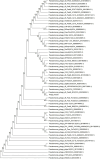Characterization of the novel broad-spectrum lytic phage Phage_Pae01 and its antibiofilm efficacy against Pseudomonas aeruginosa
- PMID: 39091310
- PMCID: PMC11292732
- DOI: 10.3389/fmicb.2024.1386830
Characterization of the novel broad-spectrum lytic phage Phage_Pae01 and its antibiofilm efficacy against Pseudomonas aeruginosa
Abstract
Introduction: Pseudomonas aeruginosa is present throughout nature and is a common opportunistic pathogen in the human body. Carbapenem antibiotics are typically utilized as a last resort in the clinical treatment of multidrug-resistant infections caused by P. aeruginosa. The increase in carbapenem-resistant P. aeruginosa poses an immense challenge for the treatment of these infections. Bacteriophages have the potential to be used as antimicrobial agents for treating antibiotic-resistant bacteria.
Methods and results: In this study, a new virulent P. aeruginosa phage, Phage_Pae01, was isolated from hospital sewage and shown to have broad-spectrum antibacterial activity against clinical P. aeruginosa isolates (83.6%). These clinical strains included multidrug-resistant P. aeruginosa and carbapenem-resistant P. aeruginosa. Transmission electron microscopy revealed that the phage possessed an icosahedral head of approximately 80 nm and a long tail about 110 m, indicating that it belongs to the Myoviridae family of the order Caudovirales. Biological characteristic analysis revealed that Phage_Pae01 could maintain stable activity in the temperature range of 4~ 60°C and pH range of 4 ~ 10. According to the in vitro lysis kinetics of the phage, Phage_Pae01 demonstrated strong antibacterial activity. The optimal multiplicity of infection was 0.01. The genome of Phage_Pae01 has a total length of 93,182 bp and contains 176 open reading frames (ORFs). The phage genome does not contain genes related to virulence or antibiotic resistance. In addition, Phage_Pae01 effectively prevented the formation of biofilms and eliminated established biofilms. When Phage_Pae01 was combined with gentamicin, it significantly disrupted established P. aeruginosa biofilms.
Conclusion: We identified a novel P. aeruginosa phage and demonstrated its effective antimicrobial properties against P. aeruginosa in both the floating and biofilm states. These findings offer a promising approach for the treatment of drug-resistant bacterial infections in clinical settings.
Keywords: Pseudomonas aeruginosa; bacteriophage; biofilm; gentamicin; multidrug resistance; phage therapy.
Copyright © 2024 Shi, Hong, Li, Zhang, Zhou, Zhao, Qiu and Liu.
Conflict of interest statement
The authors declare that the research was conducted in the absence of any commercial or financial relationships that could be construed as potential conflicts of interest.
Figures








Similar articles
-
Characterization and genomic analysis of a broad-spectrum lytic phage HZ2201 and its antibiofilm efficacy against Pseudomonas aeruginosa.Virus Res. 2023 Oct 2;335:199184. doi: 10.1016/j.virusres.2023.199184. Epub 2023 Aug 2. Virus Res. 2023. PMID: 37532140 Free PMC article.
-
Genomic characterization of a novel Pseudomonas aeruginosa bacteriophage representing the newly proposed genus Angoravirus: in vitro antimicrobial and antibiofilm activity.Int Microbiol. 2025 May 8. doi: 10.1007/s10123-025-00669-0. Online ahead of print. Int Microbiol. 2025. PMID: 40338461
-
A novel lytic phage exhibiting a remarkable in vivo therapeutic potential and higher antibiofilm activity against Pseudomonas aeruginosa.Eur J Clin Microbiol Infect Dis. 2023 Oct;42(10):1207-1234. doi: 10.1007/s10096-023-04649-y. Epub 2023 Aug 23. Eur J Clin Microbiol Infect Dis. 2023. PMID: 37608144 Free PMC article.
-
Bacteriophage therapy against Pseudomonas aeruginosa biofilms: a review.Ann Clin Microbiol Antimicrob. 2020 Sep 30;19(1):45. doi: 10.1186/s12941-020-00389-5. Ann Clin Microbiol Antimicrob. 2020. PMID: 32998720 Free PMC article. Review.
-
Challenges and Promises for Planning Future Clinical Research Into Bacteriophage Therapy Against Pseudomonas aeruginosa in Cystic Fibrosis. An Argumentative Review.Front Microbiol. 2018 May 4;9:775. doi: 10.3389/fmicb.2018.00775. eCollection 2018. Front Microbiol. 2018. PMID: 29780361 Free PMC article. Review.
Cited by
-
Isolation and Characterization of a Lytic Phage PaTJ Against Pseudomonas aeruginosa.Viruses. 2024 Nov 21;16(12):1816. doi: 10.3390/v16121816. Viruses. 2024. PMID: 39772127 Free PMC article.
-
The high efficiency protective effectiveness of a newly isolated myoviruses bacteriophage vB_AceP_PAc in protecting mice from Aeromonas caviae infection in mice.BMC Microbiol. 2025 Mar 3;25(1):112. doi: 10.1186/s12866-025-03796-w. BMC Microbiol. 2025. PMID: 40025468 Free PMC article.
-
Efficacy of phage vB_Ps_ZCPS13 in controlling Pan-drug-resistant Pseudomonas aeruginosa from urinary tract infections (UTIs) and eradicating biofilms from urinary catheters.Virol J. 2025 Jul 12;22(1):236. doi: 10.1186/s12985-025-02848-x. Virol J. 2025. PMID: 40652263 Free PMC article.
References
-
- Abdelghafar A., El-Ganiny A., Shaker G., Askoura M. (2023). A novel lytic phage exhibiting a remarkable in vivo therapeutic potential and higher antibiofilm activity against Pseudomonas aeruginosa. Eur. J. Clin. Microbiol. Infect. Dis. 42, 1207–1234. doi: 10.1007/s10096-023-04649-y, PMID: - DOI - PMC - PubMed
LinkOut - more resources
Full Text Sources
Molecular Biology Databases

